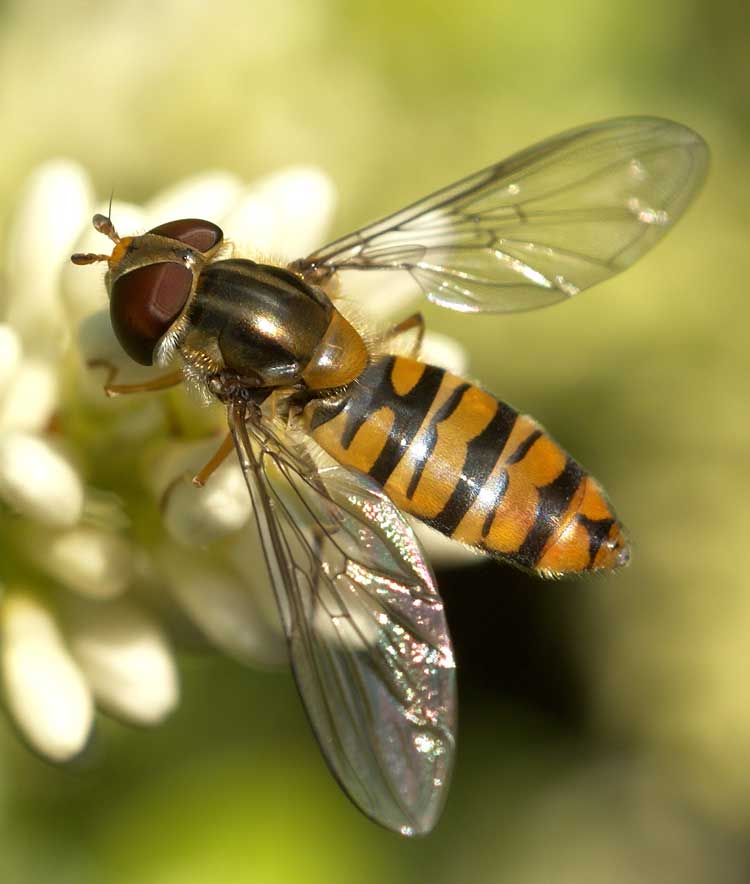
Episyrphus balteatus, female (*)
Superregnum: Eukaryota
Cladus: Unikonta
Cladus: Opisthokonta
Cladus: Holozoa
Regnum: Animalia
Subregnum: Eumetazoa
Cladus: Bilateria
Cladus: Nephrozoa
Cladus: Protostomia
Cladus: Ecdysozoa
Cladus: Panarthropoda
Phylum: Arthropoda
Subphylum: Hexapoda
Classis: Insecta
Cladus: Dicondylia
Subclassis: Pterygota
Cladus: Metapterygota
Infraclassis: Neoptera
Cladus: Eumetabola
Cladus: Endopterygota
Superordo: Panorpida
Cladus: Antliophora
Ordo: Diptera
Subordo: Brachycera
Infraordo: Muscomorpha
Sectio: Aschiza
Superfamilia: Syrphoidea
Familia: Syrphidae
Subfamilia: Syrphinae
Genus: Episyrphus
Species: Episyrphus balteatus
Name
Episyrphus balteatus (De Geer, 1776)
Vernacular names
Deutsch: Hainschwebfliege
English: Marmalade hoverfly
français: Syrphe ceinturé
magyar: Ékfoltos zengőlégy
Nederlands: Pyjamazweefvlieg
Türkçe: Reçel sineği
Episyrphus balteatus, sometimes called the marmalade hoverfly,[2] is a relatively small hoverfly (9–12 mm) of the Syrphidae family, widespread throughout the Palaearctic region, which covers Europe, North Asia, and North Africa. The upper side of the abdomen is patterned with orange and black bands. Two further identification characters are the presence of secondary black bands on the third and fourth dorsal plates and faint greyish longitudinal stripes on the thorax. Its color patterns may appear wasp-like to other animals, such as birds, protecting it from predation.[3]
E. balteatus can be found throughout the year in various habitats, including urban gardens, visiting flowers for pollen and nectar. They often form dense migratory swarms, which may cause panic among people for their resemblance to wasps. It is among the very few species of flies capable of crushing pollen grains and feeding on them. The larva is terrestrial and feeds on aphids.
As in most other hoverflies, males can be easily identified by their holoptic eyes, i.e., left and right compound eyes touching at the top of their heads.[4][5][6][7]
Gallery
Female marmalade fly feeding on a Hebe speciosa flower
Close-up of the head of a male sitting on a flower of a grey-haired rockrose (Cistus incanus): The fly head has a diameter of 0.1 in (2.5 mm).
Group on hogweed
References
Harris, M. (1780). An exposition of English insects. Vol. Decads III, IV. London: Robson Co. pp. 73–99, 100–138, pls. 21-30, 31–40. Retrieved 16 July 2021.
"Marmalade hoverfly - Episyrphus balteatus". Natural England. Archived from the original on November 20, 2008. Retrieved December 17, 2009.
Bain, R. S., et al. (2007). The key mimetic features of hoverflies through avian eyes. Proceedings of the Royal Society of London B: Biological Sciences, 274(1621), 1949-54.
Ball, S.G.; Morris, R.K.A. (2000). Provisional atlas of British hoverflies (Diptera, Syrphidae). Monks Wood, UK: Biological Record Centre. pp. 167 pages. ISBN 978-1-870393-54-6.
Morris, Roger K. A. (1999). Hoverflies of Surrey. Surrey Wildlife Trust. p. 244. ISBN 978-0-9526065-3-6.
Stubbs, Alan E.; Falk, Steven J. (1983). British Hoverflies: An Illustrated Identification Guide. British Entomological & Natural History Society. p. 253, xvpp.
Van Veen, M.P. (2004). Hoverflies of Northwest Europe, Identification Keys to the Syrphidae (Hardback). Utrecht: KNNV Publishing. p. 254. ISBN 978-90-5011-199-7.
Verrall, G.H. (1901). British flies, vol. 8: Platypezidae, Pipunculidae and Syrphidae of Great Britain, reprint, 1969, E. W. Classey, Hampton.
Chiney, Michael (2007), Insects of Britain and Western Europe. Domino Guides, A&C Black, London
Retrieved from "http://en.wikipedia.org/"
All text is available under the terms of the GNU Free Documentation License

